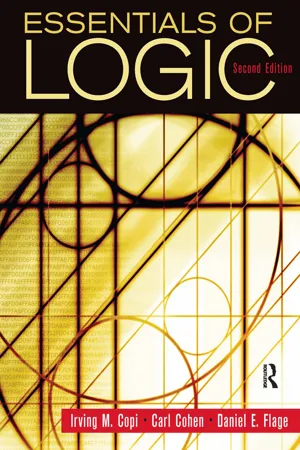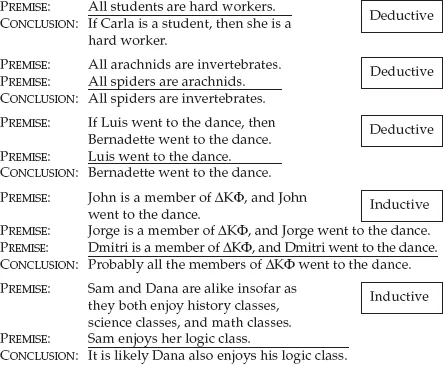
- 463 pages
- English
- ePUB (mobile friendly)
- Available on iOS & Android
eBook - ePub
Essentials of Logic
About this book
Rendered from the 11th Edition of Copi/Cohen, Introduction to Logic, the most respected introductory logic book on the market, this concise version presents a simplified yet rigorous introduction to the study of logic. It covers all major topics and approaches, using a three-part organization that outlines specific topics under logic and language, deduction, and induction. For individuals intrigued by the formal study of logic.
Frequently asked questions
Yes, you can cancel anytime from the Subscription tab in your account settings on the Perlego website. Your subscription will stay active until the end of your current billing period. Learn how to cancel your subscription.
No, books cannot be downloaded as external files, such as PDFs, for use outside of Perlego. However, you can download books within the Perlego app for offline reading on mobile or tablet. Learn more here.
Perlego offers two plans: Essential and Complete
- Essential is ideal for learners and professionals who enjoy exploring a wide range of subjects. Access the Essential Library with 800,000+ trusted titles and best-sellers across business, personal growth, and the humanities. Includes unlimited reading time and Standard Read Aloud voice.
- Complete: Perfect for advanced learners and researchers needing full, unrestricted access. Unlock 1.4M+ books across hundreds of subjects, including academic and specialized titles. The Complete Plan also includes advanced features like Premium Read Aloud and Research Assistant.
We are an online textbook subscription service, where you can get access to an entire online library for less than the price of a single book per month. With over 1 million books across 1000+ topics, we’ve got you covered! Learn more here.
Look out for the read-aloud symbol on your next book to see if you can listen to it. The read-aloud tool reads text aloud for you, highlighting the text as it is being read. You can pause it, speed it up and slow it down. Learn more here.
Yes! You can use the Perlego app on both iOS or Android devices to read anytime, anywhere — even offline. Perfect for commutes or when you’re on the go.
Please note we cannot support devices running on iOS 13 and Android 7 or earlier. Learn more about using the app.
Please note we cannot support devices running on iOS 13 and Android 7 or earlier. Learn more about using the app.
Yes, you can access Essentials of Logic by Irving Copi,Carl Cohen,Daniel Flage in PDF and/or ePUB format, as well as other popular books in Philosophy & Logic in Philosophy. We have over one million books available in our catalogue for you to explore.
Information
CHAPTER ONE
BASIC LOGICAL CONCEPTS
1.1 WHAT LOGIC IS
Logic is the study of the quality of arguments. Broadly speaking, an argument is an attempt to provide reasons for accepting the truth of some claim. (We give a more precise definition of argument in section 1.3.) Some arguments provide good reasons; other arguments do not. This book teaches you how to identify and evaluate arguments so that you will be able to sort good arguments from bad ones. Logic is a kind of self-defense. Understanding logic helps you to avoid being fooled. It encourages you to seek good reasons for your beliefs. Understanding logic also enables you to construct better arguments of your own. Arguments help us to determine whether or not to believe what we read in the newspaper or see on television. They help us reach decisions. They are the backbone of the essays that we read and write. We even use arguments when talking with friends. The skills taught in this logic book are useful in everyday life.
1.2 PROPOSITIONS AND SENTENCES
All arguments are constructed out of propositions or statements, so we begin by discussing them. A proposition is something that can be asserted or denied. A proposition is either true or false. It is true if it corresponds with the facts it describes. If it does not correspond, it is false. In this way propositions differ from questions, requests, commands, and exclamations, none of which can be asserted or denied. Although a defining feature of propositions is that they are either true or false, we may not always know whether a given proposition is true or false.
Example
The proposition “David Letterman sneezed three times on his twentyfirst birthday” is either true or false, but we will probably never know which one it is.
Questions, commands, requests, and exclamations do not make claims about the world. Unlike propositions, they do not have truth values; they are neither true nor false.
Declarative sentences are used to communicate propositions in print or speech. Sentences are not propositions. A proposition is what is meant by a declarative sentence in a certain context. Two sentences can state the same proposition. Propositions are independent of the language in which they are stated. For example, “Il pleut,” “Es regnet,” and “Está lloviendo,” are different sentences that assert the same proposition: They assert that it is raining. And, of course, there are many ways to assert the same proposition in a given language.
Example
A. George W. Bush won the 2004 U.S. presidential election.
B. The winner of the U.S. presidential election held in the year 2004 was George W. Bush.
C. George W. Bush was elected to the U.S. presidency in 2004.
These sentences differ in structure. However, they have the same meaning; they are true under the same conditions. All three sentences assert the same proposition.
Notice, too that the same sentence can be used in different contexts to assert different propositions. The time and place at which a sentence is uttered may affect the proposition it asserts.
Example
Humans have walked on the moon.
If this statement had been uttered before 1969, it would have been false. If uttered after 1969, it is true.
It is raining.
If it is raining at the place and time this sentence is uttered, it is true. At other places and times, it is false.
You are a thief!
At one time and place, this sentence might assert (truly or falsely, depending on the facts) that Bob is a thief, while at another time, it might assert (truly or falsely) that Joan is a thief.
ESSENTIAL HINTS
Logicians distinguish between propositions, statements, and sentences. A proposition is what is asserted. A statement is the proposition asserted by a sentence in a particular language. The meanings of proposition and statement are close enough to one another that we shall use them interchangeably.
In later chapters, we discuss properties of propositions. Some propositions have other propositions as parts (they are compound propositions). Others don’t (they are simple propositions). Sometimes the structures of propositions make important differences in the arguments in which they are found.
1.3 ARGUMENTS, PREMISES, AND CONCLUSIONS
An inference is a mental process by which one proposition is arrived at and affirmed on the basis of one or more other propositions that are assumed as the starting point of the process. To determine whether an inference is correct, the logician examines the propositions with which that process begins and ends and the relations among them. This cluster of propositions constitutes an argument.
Now we are ready to formulate a more precise definition of argument. An argument is a collection of propositions in which some propositions, the premises, are given as reasons for accepting the truth of another proposition, the conclusion. In the following argument:

the first two propositions are the premises. They provide reasons to believe that the conclusion, “Socrates is a mortal,” is true.
In ordinary discourse we use the word argument in other ways. For example, someone might say, “My parents divorced because they were always arguing.” But in logic we restrict the term argument to refer only to attempts to provide premises in support of conclusions. Arguments do not require disagreements.
An argument is not merely a collection of propositions. The propositions have to have a certain kind of relationship in order to be an argument. The premises of an argument must provide reasons to believe (evidence) that the conclusion is true. In practice, the premises of an argument are known or assumed before the conclusion is known.
There are two basic types of arguments. A deductive argument is an argument that attempts to prove the truth of its conclusion with certainty. This book concentrates mainly on the logic of deductive arguments. An inductive argument is one that attempts to establish its conclusion with some degree of probability. There are many kinds of deductive and inductive arguments, but the general descriptions just given always apply. Section 1.8 of this chapter gives you more information about induction, and the final chapter of the text examines some common inductive argument types in detail. Inductive and deductive arguments are evaluated according to very different standards.
Before we get to the standards for evaluating specific types of arguments, let’s continue with the general account of arguments. An argument always has at least one premise. There is no upper limit to the number of premises, but two or three is common. Additionally, there is always exactly one conclusion per argument. No single proposition by itself constitutes an argument. Here are some examples of arguments:

These five sample arguments are all arranged in standard form. In standard form, the premises are stated first and the conclusion last, with a single proposition written on each line, and a line is drawn between the premises and the conclusion. By stating arguments in standard form, you show the relationship between the premise(s) and the conclusion. But in ordinary written and verbal communication, arguments are often not stated in standard form. For example, it is very common for the conclusion of an argument to be stated first and the premises given afterwards:
The Food and Drug Administration should stop all cigarette sales immediately. After all, cigarette smoking is the leading cause of preventable death.
In this case, the first sentence is the conclusion, and the second sentence is the reason that we are supposed to accept the truth of the claim made by the first sentence.
The techniques logicians have developed for evaluating arguments require that one distinguishes between the premise(s) and conclusion of an argument. If you ...
Table of contents
- Cover
- Title Page
- Copyright Page
- Table of Contents
- Preface
- Acknowledgments
- Chapter 1 Basic Logical Concepts
- Chapter 2 Informal Fallacies
- Chapter 3 Categorical Propositions
- Chapter 4 Categorical Syllogisms
- Chapter 5 Arguments in Ordinary Language
- Chapter 6 Symbolic Logic
- Chapter 7 The Method of Deduction
- Chapter 8 Quantification Theory
- Chapter 9 Induction
- Appendix: Truth Trees
- Solutions to the Odd-Numbered Problems
- Glossary/Index